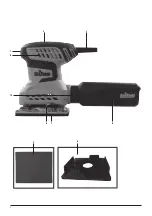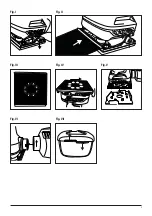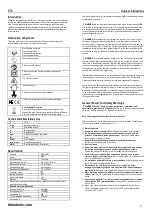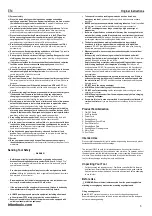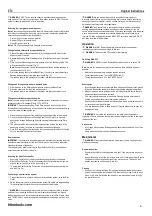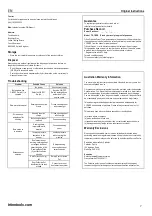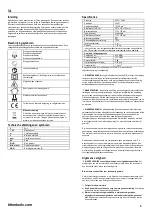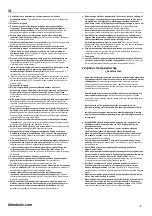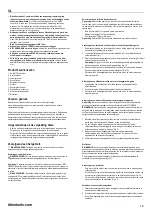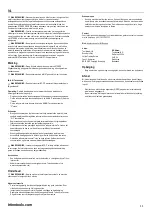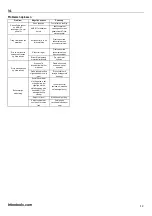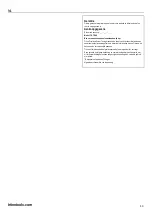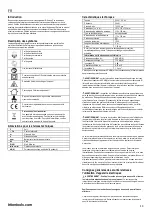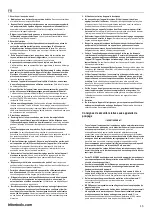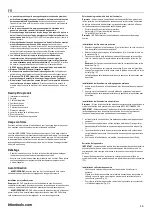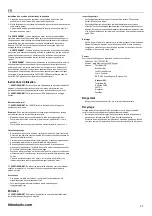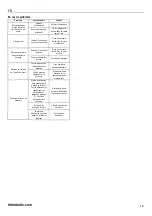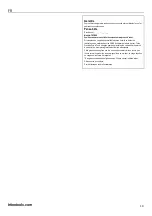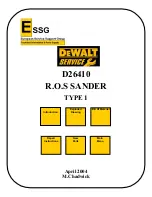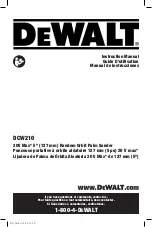
EN
Original Instructions
tritontools.com
4
Introduction
Thank you for purchasing this Triton tool. This manual contains information necessary
for safe and effective operation of this product. This product has unique features and,
even if you are familiar with similar products, it is necessary to read this manual
carefully to ensure you fully understand the instructions. Ensure all users of the tool
read and fully understand this manual. Keep these instructions with the product for
future reference.
Description of Symbols
The rating plate on your tool may show symbols. These represent important
information about the product or instructions on its use.
Wear hearing protection
Wear eye protection
Wear breathing protection
Wear head protection
Wear hand protection
Read instruction manual
Class II construction (double insulated for additional
protection)
Toxic fumes or gases!
Indoors use only!
Dust extraction required or recommended
Conforms to relevant legislation and safety standards.
Environmental Protection
Waste electrical products should not be disposed of with
household waste. Please recycle where facilities exist. Check
with your local authority or retailer for recycling advice.
Technical Abbreviations Key
V
Volts
A, mA
Ampere, milli-Amp
~, a.c.
Alternating current
n
0
No load speed
n
Rated speed
opm
Orbits or oscillations per minute
Hz
Hertz
W, kW
Watt, kilowatt
/min or min
-1
Operations per minute
dB(A)
Decibel sound level (A weighted)
Specification
Voltage:
230V~50Hz
Power:
200W
No load speed:
12,000min
-1
Dimensions (L x W x H):
257 x 114 x 150mm
Base measurements:
110 x 100mm
Sanding sheet type:
Hook and loop
Sanding sheet dimensions:
113 x 105mm
Protection class:
Ingress protection:
IP20
Power cord length:
3m
Weight:
1.35kg
As part of our ongoing product development, specifications of Triton products
may alter without notice.
Sound & vibration information
Sound pressure L
PA
:
84.5dB(A)
Sound power L
WA
:
73.5dB(A)
Uncertainty K:
3dB
Typical weighted vibration a
h
:
6.33m/s
2
Uncertainty K:
1.5m/s
2
The sound intensity level for the operator may exceed 85dB(A) and sound protection
measures are necessary.
WARNING:
Always wear ear protection where the sound level exceeds 85dB(A)
and limit the time of exposure if necessary. If sound levels are uncomfortable, even
with ear protection, stop using the tool immediately and check the ear protection is
correctly fitted and provides the correct level of sound attenuation for the level of
sound produced by your tool.
WARNING:
User exposure to tool vibration can result in loss of sense of touch,
numbness, tingling and reduced ability to grip. Long term exposure can lead to a
chronic condition. If necessary, limit the length of time exposed to vibration and use
anti-vibration gloves. Do not operate the tool with hands below a normal comfortable
temperature, as vibration will have a greater effect. Use the figures provided in the
specification relating to vibration to calculate the duration and frequency of operating
the tool.
WARNING:
The vibration emission during actual use of the power tool can differ
from the declared total value depending on the ways in which the tool is used. There
is the need to identify safety measures to protect the operator that are based on an
estimation of exposure in the actual conditions of use (taking account of all parts of
the operating cycle such as the times when the tool is switched off and when it is
running idle in addition to the trigger time).
The declared vibration total value has been measured in accordance with a standard
test method and may be used for comparing one tool with another. The declared
vibration total value may also be used in a preliminary assessment of exposure.
Sound levels in the specification are determined according international standards.
The figures represent normal use for the tool in normal working conditions. A poorly
maintained, incorrectly assembled, or misused tool, may produce increased levels of
noise and vibration. www.osha.europa.eu provides information on sound and
vibration levels in the workplace that may be useful to domestic users who use tools
for long periods of time.
General Power Tool Safety Warnings
WARNING: Read all safety warnings, instructions, illustrations and
specifications provided with this power tool.
Failure to follow all instructions listed
below may result in electric shock, fire and/or serious injury.
Save all warnings and instructions for future reference.
The term “power tool” in the warnings refers to your mains-operated (corded) power
tool or battery-operated (cordless) power tool.
1) Work area safety
a)
Keep work area clean and well lit.
Cluttered or dark areas invite accidents.
b)
Do not operate power tools in explosive atmospheres, such as in the
presence of flammable liquids, gases or dust.
Power tools create sparks
which may ignite the dust or fumes.
c)
Keep children and bystanders away while operating a power tool.
Distractions can cause you to lose control.
2) Electrical safety
a)
Power tool plugs must match the outlet. Never modify the plug in any way.
Do not use any adapter plugs with earthed (grounded) power tools.
Unmodified plugs and matching outlets will reduce risk of electric shock.
b)
Avoid body contact with earthed or grounded surfaces, such as pipes,
radiators, ranges and refrigerators.
There is an increased risk of electric shock
if your body is earthed or grounded.
c)
Do not expose power tools to rain or wet conditions.
Water entering a power
tool will increase the risk of electric shock.
d)
Do not abuse the cord. Never use the cord for carrying, pulling or
unplugging the power tool. Keep cord away from heat, oil, sharp edges or
moving parts.
Damaged or entangled cords increase the risk of electric shock.
e)
When operating a power tool outdoors, use an extension cord suitable for
outdoor use.
Use of a cord suitable for outdoor use reduces the risk of electric
shock.
f)
If operating a power tool in a damp location is unavoidable, use a residual
current device (RCD) protected supply.
Use of an RCD reduces the risk of
electric shock.
g)
When used in Australia or New Zealand, it is recommended that this tool is
ALWAYS supplied via Residual Current Device (RCD) with a rated residual
current of 30mA or less.
Содержание TQTRSS
Страница 2: ...2 3 2 10 1 9 5 7 4 8 6...
Страница 3: ...3 Fig II Fig I Fig III Fig V Fig IV Fig VI Fig VII...
Страница 51: ...RU tritontools com 51 1 a b c 2 a b c d e f g 30 3 a b c d e f g h 4 a b c d e f g h 5 30 a FFP2...
Страница 54: ...RU tritontools com 54 1 Triton 7 6...
Страница 55: ...RU tritontools com 55...
Страница 56: ......


